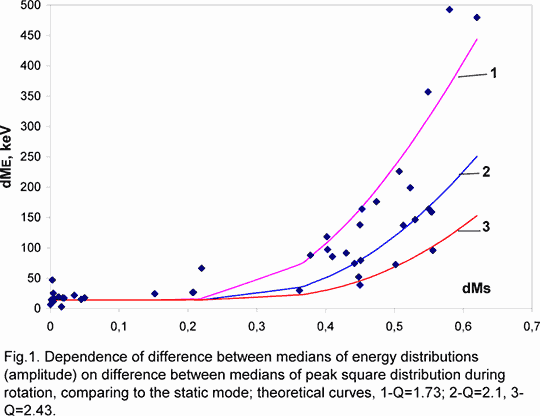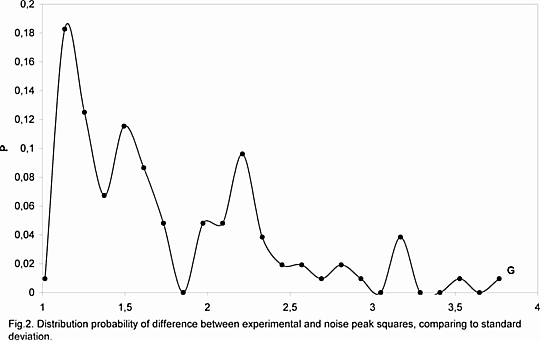|
|
|
Igor A. Melnik
abstract
There have been obtained experimental results on remote effects of rotating objects on readings of semiconductor gamma – ray spectrometric equipment and devices. It is shown that the trace shift of statistic distribution is the function of velocity changes in semiconductor detector’s charges accumulation. In its turn, the accumulation rate is subject to a physical field of non-electromagnetic origin created in the result of rotation.
Introduction
In the course of research of remote influence of rotating objects on semiconductor gamma-ray spectrometry readings it was founded, that, first, in rotation mode (comparing to static mode), gamma intensity readings (peak area) are decreasing; second, forms of statistical distributions histogram may spread and become multiplet [1]. Experiment data showed, that rotating systems are the source of fields of nonelectromagnetic nature, influencing both mobility and density of charge, and decay rate of atomic nucleus [2, 3]. Objective of this thesis is to reveal the reason of displacement of statistic distribution of complete absorption peak in the result of remote influence of rotating objects. There are given the experimental verification of nonelectromagnetic field influence both on gathering velocity of semiconductor charges, and on charges capturing in adhesion band.
Experiments results and their analysis
The following tools were used as measuring equipment: semiconductor, Ge(Li)-detector (PPD), cooled by liquid nitrogen; preamplifier; amplifier and amplitude-digital analyzer. Parameters measured: complete absorption peak square – S (peak), proportional to quantity of registered quanta, and center of peak — E, proportional to photon energy, from different sources of radioactive radiation. Energy resolution width didn’t exceed 3 keV (kiloelectronvolts). During one hour measuring peak center drift towards increasing or decreasing didn’t exceed 0.5 keV. Commutator or asynchronous motor, with 180-250 watt, was mounted to support. Motor shaft, rotating with angular velocity 2100 rpm and 6000 rpm, was placed vertically over radioactive isotope source on the distances, defined by experiments conditions. Sources (Cs137, Co60) were mounted on rests of different heights from semiconductor detector (PPD) strictly by vertical axis of shaft. The distance from radioactive source (of OSGI type) to detector was chosen so that peak square would correspond to S~8000-11000 pulses during time of spectrum pick-up no more than a second. Measuring was performed by alternation of two modes, ten measurements with operating motor and ten – after it stopped. In each mode hundred and more measurements were carried out both clockwise, and counter-clockwise (view from above).
There was studied the dependence of medians МS(МE) of corresponding distributions Еrot/Est and Srot/Sst, where Srot; Sst – sample values of peak square in the rotation mode and the static mode. All values of these medians are less than one. The following median dependence DМE(DМS) was plotted, where
DМS= (1-Srot/Sst) и DМE=|1-Еrot/Est|E g,
respectively Eg-is energy of registered photon in keV (Fig.1). Areas of «forbidden» band appear on diagram, and changes of amplitude distributions of signal are related with change of intensity distributions.

In thesis [2] it is demonstrated, that placement of theoretical curves depend on value Qx~1/tcob, where tcob – time of semiconductor charges gathering. Thus, values of peak square displacement and amplitude are proportionally connected with change of energy level and wave vector of semiconductor charges. In this case, electromagnetic noises do not greatly influence on the respective value of distributions shift. Experimental data support this conclusion. For instance, at joint simultaneous measuring of Со60 (1332 and 1173 keV) and Cs137 (661.6 keV), points of experimental data DМE(DМS) with energy 1332 keV and 661.6 keV were situated on curve No. 2, and 1773 keV point — on curve No.1.
Noise signals come in input stage of pre-amplifier apart from wanted signal from PPD. They are formed by detector reverse current, input current of control gate, leakage current of resistances linked up parallel to detector. Apart from internal noise signals the signals may come in pre-amplifier input, which is generated by external electromagnetic devices, in this case they are electric motor and rotation velocity control system. In its turn, load resistance of input circuit is in inverse proportion to cyclic frequency of alternating current of external noise signal. All this leads to fluctuation of load time const and increasing of square of integrated spectrum.
In this case noise current is represented in discrete form as d -pulses, generated by external electromagnetic source and substantially increasing general integral. And while «dead» time of amplitude-digital converter — tm, is «dead» time of continuing type, then wanted signal peak squares should decrease.
It is known, that counting rate in i-channel – ni is defined in the following way:
ni=n0 (1-nS tm),
where n0 – intensity of occurrences by input, corresponding to i-channel; nS — aggregated velocity of analyzer by all channels. Taking to account, that main objective of experimental research was the study of influence of working electric motor on spectrometer readings, comparing to turned-off eclectic motor, then one may write down the following equation:
Srot=Sst(1- nS D tS),
where Srot; Sst – wanted signal peak square in measuring in the motor rotation mode and in turned-off motor mode. Value D tS=tst-tSrot will be equal to zero when Srot=Sst, respectively, nS — aggregated counting rate of analyzer in the rotation mode. In the course of experiment the was made the general registration of common integrated spectrum — I, starting from the first channel of analyzer scale, i.e. bottom limit of discriminator was equal to zero. Let’s define integral as N=I-S, then we’ll receive the following equation:
Nrot=Nst(1- nS D tN),
where D tN=tst-tNrot. In general case, in the rotation mode, generated noise pulses on input stage of pre-amplifier increase «dead» time of integral on value — d ≥0, comparing to measuring at the static mode. Any statistic fluctuations of «dead» time influence proportionally both on peak square and analyzed spectrum integral. Let’s write down the following dependences:
D tS= tst- tst(1-d)=d tst;
D tN= tst- tst(1+d)= -d tst.
Thus, using these equations, one may define the dependence of peak square on integral, i.e. on noise pulses generated by external electromagnetic source:
Sshrot= Sst(1-D N/ Nst), где D N= Nrot-Nst.
Hereof it follows that having defined the value Sshrot one may find out in what conditions the modulus of difference G=|Sshrot -Srot|/2ust>1, where ust – standard deviation of sample values of peak square at measuring in the static mode. This inequality allows defining such sample values, which measuring is connected with influence of non-electromagnetic component on semiconductor spectrometry (Fig.2). Thus, one may suppose, that non-electromagnetic component has resonance nature of influence.
Analysis of circuit spectrum in cesium isotope measuring (quantum gamma energy 661.6 keV) revealed one more peak with average energy 669.6 keV. Its occurrence frequency (i) in sampling is different for different modes and measuring geometry. Let’s name it peak-double – Sd. If there are no changes in the static mode Sd1st=874 pulses, mean-square error — s=54.1, i=15% respectively, the we may define the average square of peak-double taking to account occurrence frequency in sampling of circuit spectrum, i.e. sd=Sdi/100, where sd1st=131 pulses. When rotating counter-clockwise Sd1pr=1197 pulses, s=15.5, i=76%, sd1pr=917 pulses. Thus, there is a significant increasing of peak-double square in the rotation mode comparing to the static mode. Difference in readings of peak-double energy when comparing modes (Pr-mode of rotation counter-clockwise) and (St-static mode), comprises DEstpr=0.87 keV when spr=0.04 keV. Increasing of detector load also makes peak-double bigger, for instance, in simultaneous measuring of two cesium isotope sources the following values were defined: sd3st=1442 pulses, sd3pr=1869 pulses.

To study the behavior of peak-double depending on energy of registered photon, peaks Со60 with energy 1173 keV and 1332 keV were studied in the following experiments simultaneously with cesium, and respectively peak-doubles squares with energy 1183 keV and 1343 keV. The results of the experiments are entered in the table. In this case the energy of registered radiation and detector load are increasing. In the course of experiment with cobalt, the difference of cesium peak-double displacement energy is the following DEstpr=1.37 keV when spr =0.087 keV. Correlation analysis of sampling, received in the rotation mode, demonstrated the presence of both positive and negative correlation of peak square and peak-double square (correlation ratio – |k|>0.6).
|
|
S661 |
S1173 |
S1332 |
sd669 |
sd1183 |
sd1343 |
|
St |
10123 |
9505 |
8886 |
1829 |
120 |
0 |
|
Pr |
5536 |
4742 |
3988 |
687 |
710 |
522 |
|
Po |
7085 |
6386 |
5769 |
1331 |
1543 |
1173 |
Change of gathering time influences the behavior of peak-double. The appearance of this peak is conditioned by the effect of temporary recombination (adhesion) of charges [4]. Time of capturing charges in adhesion band – tpr=N/[gNp(N-nz)], where N-concentration of adhesion levels; nz-concentration of charges in adhesion traps and g=sv recombination const, where, s — capture cross-section. In this case, Np – density of free hole states «reduced» to traps level depends on the depth of traps demarcation level — ED. Position of this level is defined by the same probability of thermal filling-up and recombination. If to denote the number of efficient hole states as – nef=Lm3/2, where L-const, а m-effective mass, then Np= nefexp{[-Ez+ED]/kT} where, Ez-forbidden band width; k-Boltzmann constant; T — temperature. If tpr<(t-tcob), the pulse amplitude component, conditioned by discharge of previously captured carriers, will increase output amplitude on ~1% (peak-double appears). When tprі(t-tcob), output amplitude will correspond to absorption peak amplitude. Thus, the probability of peak-double occurrence will depend on relation of mean values tcob and tpr, f=(t-tcob)/tpr, i.e. sd~[1-exp(-f)]. In equation of charge capturing time, divisor gNp(N-nz) is the intensity of thermal filling-up from hole adhesion band to valence band, and difference N-nz, is the concentration of non-filled adhesion levels. Thus, when energy of quantum gamma energy will increase, difference N-nz will become less, respectively sd will also become less (first line of the table). Decreasing the time of charge gathering and increasing the effective mass make the probability of peak-double occurrence greater. Therefore, influence of nonelectromagnetic filed component on listed values also indirectly influences statistic distributions of peak-double. In its turn, the more defects in crystal stricture of PPD (i.e. N), the less tpr is and the grater peak-double is. Respectively, this approach may be used in defectoscopy of semiconductor detectors.
Conclusions
The following conclusions may be drawn on the basis of carried out researches:
-rotation is the source of physical filed, which properties coincide with torsion filed ones, and therefore, all listed effects may be interpreted as influence of this fields on substance [5].
-the filed influences quantum systems in nonequilibrium state [6].
-system «radioactive source – semiconductor detector» may be used as torsion field sensor, for the purpose of studying the potentials distribution in the space of the rotating object.
References
- [1] I.A.Melnik, «Experimental detection of the influence of a rotation on the statistical distribution on the instrumental spectrum of isotope gamma-radiation», Rus.Physic.Jour., no.5, pp. 19-26, 2004.
- [2] I.A.Melnik, «Remote influence of rotating objects on semiconductor gamma-ray detector», New Energy Technol., no. 1, рp.58-69, 2005.
- [3] I.A.Melnik «Remote influence of rotation on radioactive decay», New Energy Technol., no. 2, рp.33-36, 2005.
- [4] S.M.Ryvkin, «Photoelectric phenomena in semiconductors», Moskva, Physmathgiz, 1963, 220 pages.
- [5] G.I.Shipov, «Theory of physical vacuum», Moskva, NT-Center, 1993, 362 pages.
- [6] V.G. Bagrov, I.L. Bukhbinder, I.L. Shapiro, «Possible experimental manifestations of torsion field»,Rus.Physic.Jour.,no.3, pp. 5-12, 1992.
Igor A. Melnik, Remote action of rotation on the semiconductor detector of gamma-ray radition // «Академия Тринитаризма», М.,
|
|